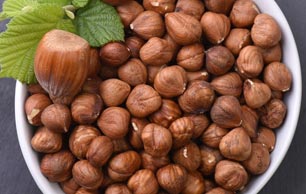Nuts
A nut is a fruit composed of an inedible hard shell and a seed, which is generally edible. In general
usage and in a culinary sense, a wide variety of dried seeds are called nuts, but in a botanical
context “nut” implies that the shell does not open to release the seed (indehiscent). The
translation of “nut” in certain languages frequently requires paraphrases, as the word is ambiguous.
Nuts being sold in a market
Most seeds come from fruits that naturally free themselves from the
shell, unlike nuts such as hazelnuts, chestnuts, and acorns, which have hard shell walls and
originate from a compound ovary. The general and original usage of the term is less restrictive, and
many nuts (in the culinary sense), such as almonds, pecans, pistachios, walnuts, and Brazil nuts,
are not nuts in a botanical sense. Common usage of the term often refers to any hard-walled, edible
kernel as a nut. Nuts are an energy-dense and nutrient-rich food source

Cashews
Cashews are a kidney-shaped seed sourced from the cashew tree — a tropical tree native to Brazil
but now cultivated in various warm climates across the world.
Although commonly referred to as tree nuts, and nutritionally comparable to them, cashews are
really seeds. They’re rich in nutrients and beneficial plant compounds and make for an easy
addition to many dishes.
Like most nuts, cashews may also help improve your overall health. They’ve been linked to
benefits like weight loss, improved blood sugar control, and a healthier heart.
This article reviews the nutrition, benefits, and downsides of cashews to determine whether
they’re good for you.

Hazelnut
The hazelnut is the fruit of the hazel and therefore includes any of the nuts deriving from species of the genus Corylus, especially the nuts of the species Corylus avellana. They are also known as cobnuts or filberts according to species.

Peanut
The peanut, also known as the groundnut,[2] is a legume crop grown mainly for its edible seeds.
It is widely grown in the tropics and subtropics, being important to both small and large
commercial producers. It is classified as both a grain legume[4] and, due to its high oil
content, an oil crop.[5] World annual production of shelled peanuts was 44 million tonnes in
2016, led by China with 38% of the world total. Atypically among legume crop plants, peanut pods
develop underground (geocarpy) rather than above ground. With this characteristic in mind, the
botanist Carl Linnaeus gave peanuts the specific epithet hypogaea, which means “under the
earth”.
The peanut belongs to the botanical family Fabaceae commonly known as the legume, bean, or pea
family.[1] Like most other legumes, peanuts harbor symbiotic nitrogen-fixing bacteria in root
nodules.[6] The capacity to fix nitrogen means peanuts require less nitrogen-containing
fertilizer and improve soil fertility, making them valuable in crop rotations.
Peanuts are similar in taste and nutritional profile to “tree nuts” such as walnuts and almonds,
and, as a culinary nut, are often served in similar ways in Western cuisines. The botanical
definition of a nut is “a fruit whose ovary wall becomes hard at maturity”. Using this
criterion, the peanut is not a nut.[7] However, peanuts are usually categorized as “nuts” for
culinary purposes and in common English more generally

Sesame
Sesame is a flowering plant in the genus Sesamum, also called benne. Numerous wild relatives
occur in Africa and a smaller number in India. It is widely naturalized in tropical regions
around the world and is cultivated for its edible seeds, which grow in pods. World production in
2018 was 6 million tonnes, with Sudan, Myanmar, and India as the largest producers.
Sesame
seed is one of the oldest oil seed crops known, domesticated well over 3000 years ago. Sesamum
has many other species, most being wild and native to sub-Saharan Africa. S. indicum, the
cultivated type, originated in India and is tolerant to drought-like conditions, growing where
other crops fail. Sesame has one of the highest oil contents of any seed. With a rich, nutty
flavor, it is a common ingredient in cuisines across the world. Like other seeds and foods, it
can trigger allergic reactions in some people

Super Food
Super Food is a marketing term for food assumed to confer health benefits resulting from an exceptional nutrient density. The term is not commonly used by experts, dietitians and nutrition scientists, many of whom dispute that particular foods have the health benefits claimed by their advocates. Even without scientific evidence of exceptional nutrient content, many new, exotic, and foreign fruits or ancient grains are marketed under the term – or super fruit or super grain respectively – after being introduced or re-introduced to Western markets.

